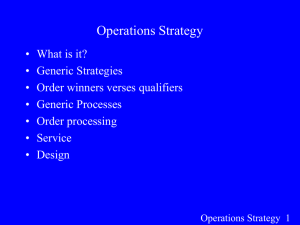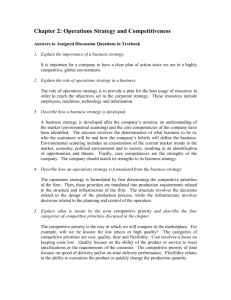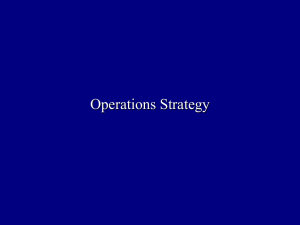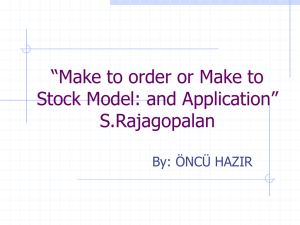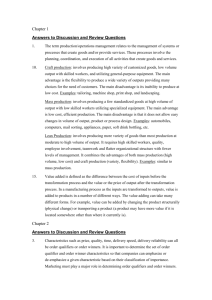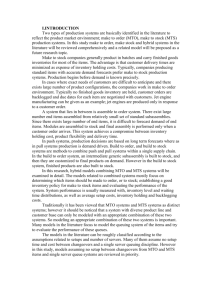chapman_01
advertisement
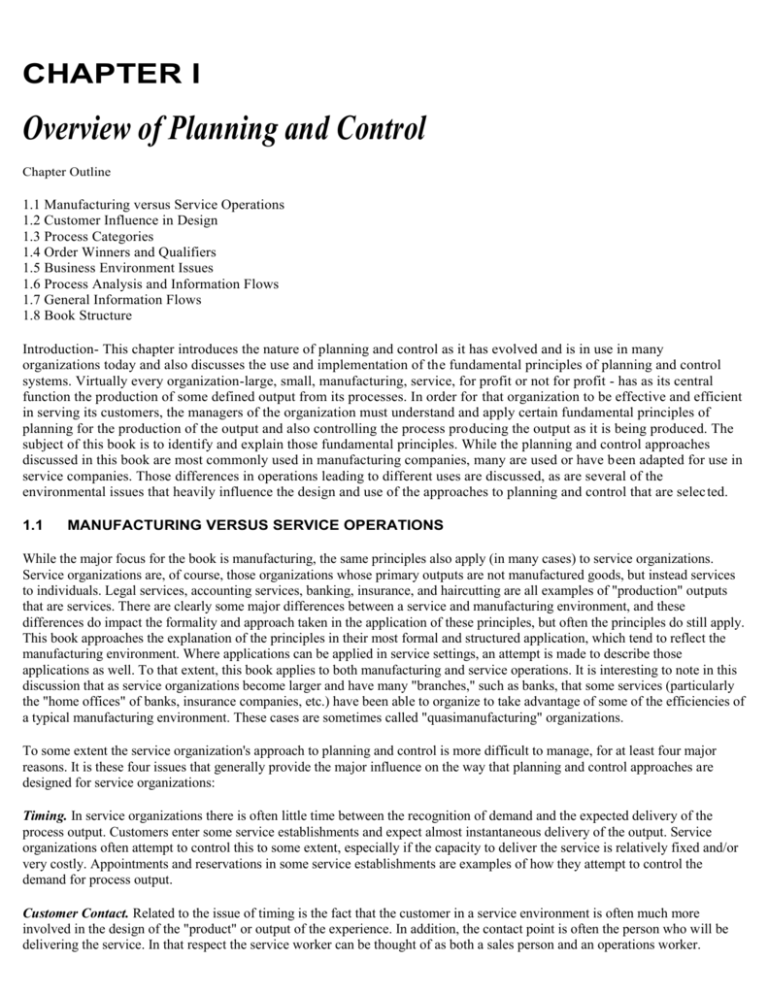
CHAPTER I Overview of Planning and Control Chapter Outline 1.1 Manufacturing versus Service Operations 1.2 Customer Influence in Design 1.3 Process Categories 1.4 Order Winners and Qualifiers 1.5 Business Environment Issues 1.6 Process Analysis and Information Flows 1.7 General Information Flows 1.8 Book Structure Introduction- This chapter introduces the nature of planning and control as it has evolved and is in use in many organizations today and also discusses the use and implementation of the fundamental principles of planning and control systems. Virtually every organization-large, small, manufacturing, service, for profit or not for profit - has as its central function the production of some defined output from its processes. In order for that organization to be effective and efficient in serving its customers, the managers of the organization must understand and apply certain fundamental principles of planning for the production of the output and also controlling the process producing the output as it is being produced. The subject of this book is to identify and explain those fundamental principles. While the planning and control approaches discussed in this book are most commonly used in manufacturing companies, many are used or have been adapted for use in service companies. Those differences in operations leading to different uses are discussed, as are several of the environmental issues that heavily influence the design and use of the approaches to planning and control that are selec ted. 1.1 MANUFACTURING VERSUS SERVICE OPERATIONS While the major focus for the book is manufacturing, the same principles also apply (in many cases) to service organizations. Service organizations are, of course, those organizations whose primary outputs are not manufactured goods, but instead services to individuals. Legal services, accounting services, banking, insurance, and haircutting are all examples of "production" outputs that are services. There are clearly some major differences between a service and manufacturing environment, and these differences do impact the formality and approach taken in the application of these principles, but often the principles do still apply. This book approaches the explanation of the principles in their most formal and structured application, which tend to reflect the manufacturing environment. Where applications can be applied in service settings, an attempt is made to describe those applications as well. To that extent, this book applies to both manufacturing and service operations. It is interesting to note in this discussion that as service organizations become larger and have many "branches," such as banks, that some services (particularly the "home offices" of banks, insurance companies, etc.) have been able to organize to take advantage of some of the efficiencies of a typical manufacturing environment. These cases are sometimes called "quasimanufacturing" organizations. To some extent the service organization's approach to planning and control is more difficult to manage, for at least four major reasons. It is these four issues that generally provide the major influence on the way that planning and control approaches are designed for service organizations: Timing. In service organizations there is often little time between the recognition of demand and the expected delivery of the process output. Customers enter some service establishments and expect almost instantaneous delivery of the output. Service organizations often attempt to control this to some extent, especially if the capacity to deliver the service is relatively fixed and/or very costly. Appointments and reservations in some service establishments are examples of how they attempt to control the demand for process output. Customer Contact. Related to the issue of timing is the fact that the customer in a service environment is often much more involved in the design of the "product" or output of the experience. In addition, the contact point is often the person who will be delivering the service. In that respect the service worker can be thought of as both a sales person and an operations worker. Quality. A key dimension of quality in service organizations is that much of the quality may be intangible, making it much more difficult to effectively measure. Inventory. "Pure" service organizations (those that have virtually no physical goods involved in their output) often do not have the luxury of inventorying their output. It is impossible, for example, to inventory a haircut. Many people in manufacturing may be taken aback by the image of inventory as a luxury, given that they are often pressed for inventory reduction, but in fact inventory in the perspective of manufacturing planning can be thought of as "stored capacity." Essentially, inventory (especially finished goods) can be viewed as the application of the organization's capacity prior to the actual demand for that output. It will, in this context, allow the firm to provide a somewhat smoother application of the output processes, thereby making them more efficient and often more effective. 1.2 CUSTOMER INFLUENCE IN DESIGN: PRODUCTION ENVIRONMENTAL CHOICES The design of the planning and control system will be impacted by several factors in addition to the points mentioned above. Among the most critical of these factors are the volume and variety of the expected output, and those issues in turn tend to be largely driven by the amount of influence the customer has in the design of the product or service delivered to them from the organization's processes. In some cases the issue of customer design influence is a part of the firm's basic strategy, but in some cases it is a reaction to market drivers. Many automobiles, for example, are purchased as finished goods from a dealer's lot primarily because the customers do not wish to wait for an automobile that is ordered with the exact options they want. That extent of customer influence tends to be described by the following categories, listed here in the order of influence, from less to more: Make-to-Stock (MTS). As the name implies, these are products that are completely made into their final form and stocked as finished goods. The collective customer base may have some influence on the overall design in the early product design phase, but an individual customer has essentially only one decision to make once the product is made-to purchase or not to purchase. Again, these purchase patterns can influence overall product design changes, but not usually in the case of an individual customer. Examples of these products are very common, as found in virtually all retail stores such as hardware, clothing, office supplies, and so on. Assemble-to-Order (ATO). In this case the customer has some more influence on the design, in that they can often select various options from pre designed subassemblies. The producer will then assemble these options into the final product for the customer. As in the case of the MTS, the collective customer base can influence the overall design of the options and final products, but the individual customer can only select from the specified options. Automobiles and personal computers are good examples of these types of products. If a customer orders an automobile from a dealer, for example, they can often choose from a variety of colors, body styles, engines, transmissions, and other "pure" options, such as cruise control. In some industries this approach is sometimes called Package-to-Order, in that it is the packaging that is customer specified. In products such as breakfast cereals or baking products (flour, baking soda, etc.), the product does not change, but can be placed in several different sizes and types of packages according to customer need. A service example of ATO may be in some restaurants, where the customer can specify their choice of side dishes for their meal. They may have little option as to how those side dishes are prepared, but do have some say in which ones they select. Make-to-Order (MTO). This environment allows the customer to specify the exact design of the final product or service, as long as they use standard raw materials and components. An example might be a specialty furniture maker or a bakery. In the bakery, for example, a customer may specify a special cake be produced for an occasion such as a birthday or anniversary. They have many design options for the cake and its decorations, although they may be limited to certain sizes of cake pans, cake flavorings, and so on. Engineer-to Order (ETO). In this case the customer has almost complete say in the design of the product or service. They are often not even limited to the use of standard components or raw material, but can have the producer deliver something designed "from scratch." 1.3 PROCESS CATEGORIES The nature of the customer influence issue described above not only impacts the design of the product or service, but also has a profound impact on the design of the process used to deliver the product or service. There are essentially five categories given to describe the process used in production, although in practice there are several combinations of these basic types. The five categories typically given are: Project. A project-based process typically assumes a one-of-a-kind production output, such as building a new building or developing a new software application. Projects are typically large in scope and will often be managed by teams of individuals brought together for this one-time activity based on their particular skills. The planning and control approaches to managing a project are so specialized they are not covered in this book. The reader is referred to one of the many good references specifically focused on the management of projects, such as "5-Phase Project Management" by Weiss and Wysocki. Job Process. Job processes (job shop processes) are typically designed for flexibility. The equipment is often general purpose, meaning it can be used for many different production requirements. The skill in delivering the production as specified by the customer is generally focused on the workers, who tend to be highly skilled in a job process. This environment is generally focused for production of a large variety of special production requirements, as may be found in an ETO or MTO design environment. The high variety of design requires the flexible processes and higher skills of the workforce. Work in these environments will often move in a very "jumbled" fashion because of the high variability in designs for each job. Again because of the variability in design and work requirements, information linkages tend to be informal and loose. An example is a generalpurpose machine shop or a specialty bakery or caterer. Batch or Intermittent Processing. Many of the production facilities in the world today fall into this "middle of the road" category. The equipment tends to be more specialized than the equipment in job shops, but still flexible enough to produce some variety in design. As more of the "skill" to produce the product rests in the more specialized equipment, the workers do not usually need to be quite as skilled as the workers in the job shops. Often these organizations are organized with homogeneous groupings of worker skills and a machine, forcing the work to move from area to area as it is being processed. The category is often called batch since products are often made in discrete batches. For example, a batch process may make several hundred of one model of product, taking many hours before they switch the setup to produce another batch of a slightly different model. Some batch processes can produce MTO and some MTS, but this environment is usually well suited to the ATO environment. There are many examples of products built in this environment, including clothing, bicycles, furniture, and so on. Repetitive or Flow Processing. As the name implies, this type of process facility tends to be used for a very large volume of a very narrow range of designs. The equipment tends to be highly specialized and expensive, requiring little labor, and the labor that is used tends to be unskilled. The expense of the special equipment is placed into the overhead cost category, allowing the relatively fixed cost to be spread over a large volume. This makes the cost per item lower, making it price competitive. Repetitive processing is typically used for make-to-stock (MTS) designs, such as refrigerators and other appliances. Continuous. As with project processing, this type of process is at the far extreme of the processing types, again making it focused on highly specialized applications. The equipment is very specialized, and little labor tends to be needed. High volume chemical processes and petroleum refining will fall into this category. This book will cover some, but few of the fairly specialized planning and control issues in this category. Job process Batch Repetitive Equipment General purpose Semi -specialized Highly specialized Labor skills Highly skilled Semi-skilled Low skills Managerial approach Technical problem solver Team leadership Efficiency - keep the process moving Medium High Medium Low MTO, ATO, MTS ATO, MTS Highly defined and fixed Volume output per Low design Variety of designs High produced Design environment ETO, MTO Flow of work Variable, jumbled More defined While these are the common types, it should be noted that some products are produced in "hybrid" operations, which can be thought of as combinations of these common types. For example, some chemicals might be produced in a ·continuous process, but then packaged in a batch environment. Table 1.1 summarizes some of the key points and differences between the middle three types of processes: job process, batch, and repetitive. In addition, there are several implications for planning and control that will need to be highly specialized and different across these types of processing environments. Virtually all aspects of planning and control will be impacted depending on the type of production environment. An easy way to illustrate the differences in volume and variety relating to the various process types was developed several years ago by Robert Hayes and Steven Wheelwright, often called the Hayes-Wheelwright Product/Process Matrix. As can be seen in an example of the matrix in Figure 1.1, the horizontal axis shows the range of products from high variety of designs with low volumes (MTO) to those with little variety in design and high volumes (MTS). The vertical axis shows the range of processes, from those with general-purpose machines with variable flow to those with fixed flow. The diagonal shows the optimal type of processing that is usually used for each type of product. It should be noted that producing a product or service off the diagonal is not impossible, just often not wise from a business perspective. It is not that one cannot produce off the diagonal, but more that one should not. An example may illustrate. Take the example of a quarter-pound hamburger produced in a fast-food restaurant. That would fall into the lower right-hand quadrant of the matrix, in that it is a low-variety, high-volume product typically produced in a fairly rigid, repetitive process in a fast-food restaurant. Now the question could be asked if a fancy, gourmet restaurant could also produce such a hamburger. Clearly they would have both the equipment and skills to produce such a product- but to do so would place them in the upper right-hand quadrant. The additional cost in this case is represented by the highly skilled and expensive labor in such a restaurant, which represents an opportunity cost (such skilled labor would be better utilized to produce a meal with higher profit margins). In this case, they could produce the product, but could not compete well in the price-sensitive market that typifies such a standard high volume product. To explain the other "off-diagonal" (lower left-hand part of the matrix), we could ask the question "Can a typical fast-food restaurant produce a fancy prime rib dinner?" The answer is possibly yes, but to do so would clearly take an investment in equipment and training for the employees. Therefore, it may be possible, but not without extensive extra costs. 1.4 ORDER WINNERS AND QUALIFIERS Another aspect of the business environment that will impact the design and management of the planning and control system is the market drivers for the product or service. To start this discussion, it first must be recognized that there are several dimensions by which customers in the market may evaluate the desirability of buying a certain product or service from a given producer. Some of the more important dimensions of competition include: 1. Price. Usually related to cost of product or service. There are two primary types of price categories: a. Standard price, such as a catalog price b. Custom pricing, usually negotiated 2. Quality. There are two major aspects to consider. a. b. Tangible quality, including those aspects for which specific measures can often be developed. These can include standard quality measures such as conformance, reliability, and durability. Intangible quality, including those aspects that may prove of value to the customer, yet are difficult to specifically measure. They may include such aspects as reputation (brand), aesthetics, responsiveness, and customer service. 3. Delivery. Again, there are two major aspects: a. Speed-how quickly can the product or service be delivered? b. Reliability - once a promise for delivery is made, is it kept? 4. Flexibility. Two major issues must be considered: a. b. Volume-can the producer easily produce a wide range of product volumes? Variety-can the producer easily produce a wide range of product designs and/or options? It should be noted that these four major dimensions on this list are major issues for the production function within the organization. There are issues that tend to be heavily shared by nonproduction functional areas of responsibility, such as marketing and engineering. A prime example is the issue of intangible quality, many aspects of which are often the responsibility of functions other than direct production. It also should be noted that it is virtually impossible for anyone producer to be the "best" in the market for all these dimensions of competition at the same time. As part of the development of the operations strategy of the firm, the producer must determine which of these dimensions represent order winners and which are order qualifiers for their market as defined by the corporate strategy. Order qualifiers. order qualifiers represent the dimension by which a potential customer determines which suppliers of a product or service meet certain criteria to be considered for receiving the final order from the customer. Qualifiers only allow consideration, and meeting the order-qualifying criteria does not necessarily mean the supplier will be successful winning the order. Not meeting the criteria, on the other hand, will almost ensure the order will not be won. Order winners. once potential suppliers have been evaluated as to their order-qualifying criteria, the final successful supplier for the product or service is selected based on the order-winning criteria in the mind of the customer. As an example, suppose a person is in the market for a basic color television. They may first check out producers that have a reputation for quality and reliability (order qualifiers). They may then look at sample pictures and products from the producers that qualify on the quality and reliability perspective, and further reduce the possible products based on the features mid basic look of the television (another qualifier). Finally, they may actually purchase the television from the possible qualifying products based on price (the order winner). 1.5 BUSINESS ENVIRONMENT ISSUES A major message from the discussion above is that it is critical for a producer to understand their market(s) and design their systems to at least meet the minimum level of criteria for the order qualifiers in their market, but at the same time strive to be the best in those dimensions that represent order winners. While that may appear on the surface to be a fairly basic and simple approach, there are a number of complicating issues. They include: Customer "learning." Competitors often attempt to approach the market in the same way (emphasizing the same competitive dimensions) as each other, but from time to time a competitor may attempt to gain market share by emphasizing they are the "best" at it. As this happens, the customer expectation may also change. For example, if delivery speed is an order winner, as producers change their system to improve delivery speed, the customers may come to expect an ever-shrinking delivery time, continually "raising the bar" for all companies in the market. Competitor moves. Some competitor moves may disqualify order winners, turning them into qualifiers, and thereby establishing new order winners. For example, suppose an order winner in a market has been price. The competitors have been working hard to cut costs, thereby allowing lower prices to be charged. Suppose all the competitors have developed cost controls to now charge almost equal prices-to the point where customers perceive very little difference. In such a market, they may become sensitive to another order winner, such as delivery speed. If all competitors have roughly the same price, but one has a much faster delivery, then the order winner may now become delivery speed, leaving price as a qualifier. Effective marketing and advertising plans can also sometimes change customer perceptions as to what is important as an order-winning dimension. Multiple markets. It is likely that most companies have numerous products or services serving numerous markets. In such cases, there may be many different order qualifiers in many different markets - and all may be subjected to the changes described in the first two points. The effective producer needs to be aware of and continually monitor all the markets, and the company planning and control systems need to effectively support all. Product design changes. New products and changes in product design, especially as technology impacts customer expectations, will also often change order winners and qualifiers. A good example of this is how Internet technology has altered customer perception of how to purchase many goods and services. As the discussion in further chapters progresses, there will be several references to different approaches to designing and managing the planning and control of an operation that will be impacted by several of these issues. For example, the approach to inventory and capacity may be very different for a company competing on price as opposed to a company competing on delivery speed. Companies competing on price may want to have very little extra capacity or inventory because of the cost involved, but a lean approach to capacity and inventory may have a negative impact on delivery speed. In contrast, a company competing on delivery may be willing to accept the extra cost of extra buffer inventory or capacity to ensure they are able to meet the customer expectation of delivery speed. 1.6 PROCESS ANALYSIS AND INFORMATION FLOWS In the previous discussion we see how the business environment (the external environment) can impact the design of planning and control approaches. There are also several issues that must be determined with respect to the analysis of the internal processes used to deliver goods and services to the customer. The first of these issues is one of process analysis and improvement. There are several aspects to process analysis and improvement, including: 1. 2. 3. 4. Control and reporting points. These are points in the process where the activities of production are captured. They often require formal, structured process transactions, and many times also represent points where formal scheduling of production activity is required. Some systems, such as Material Requirements Planning, may require many of these points while others, such as Just-in-Time, may require very few. These will become clearer as the explanation of those and other systems become better developed. Process analysis and improvement. As production and production processes change in response to the business conditions mentioned above, the change in processes needs to be improved systematically to ensure it matches the needs of the business in the best manner possible. Some of these approaches include: Process mapping. Process mapping involves developing a detailed flow of information and activities used to produce some defined activity. It will often indicate times for those activities and assign responsibilities. Development and analysis of these process maps may be used to determine completeness-are all critical activities and transactions being captured? efficiency-are there activities or transactions that are not needed and therefore adding cost without adding value? redundancy - are there multiple activities essentially accomplishing the same task or collecting data more than once? effectiveness-are all activities and transactions done in the best manner? Process improvement. there are several methods for evaluating and improving processes that have been developed over the past several years. Some of them have been developed into an approach known as Kaizen, a Japanese word generally meaning "continuous improvement." The general issue here is one of incremental, as opposed to radical, process improvement. Process reengineering. If there are substantial problems with a process, it may need to be completely redesigned. Using only the definition of the inputs and required outputs of the process, a new process can be developed to most effectively use the inputs to meet the demands of the process output. Unlike Kaizen, process reengineering generally implies a radical change in the process. Value stream mapping. This process analysis and improvement approach is generally considered to be associated with Lean Production, but could be effectively used in almost any environment. The analysis starts with the customer, and generally includes Takt time, or sometimes called the "heartbeat of the customer." It is found by taking the average customer demand for a given time period (a day, for example), and dividing that number by the amount of time available for production during that day. The result gives the average amount of product required to be produced per unit of time in order to meet customer demand. In addition, the value stream map includes inventory level and queue times for material throughout the process, and compares that to value-added time. That comparison provides a very good estimation of the opportunity to improve. Finally, the value stream map provides information flows that are not often part of a regular process map. Once the current state value stream map is completed, the opportunity exists to make appropriate improvements in the process. It is important to note that all improvement and mapping activities need to be accomplished in the context of a vision based on a company strategy, and that all measures for improved processes be linked to the strategic imperatives of the company. 1.7 GENERAL INFORMATION FLOWS The diagram in Figure 1.2 illustrates the general flow of information for planning and control for many manufacturing firms. All these activities will be explained in some detail in subsequent chapters, but in general, as the diagram flows from top to bottom, the level of detail increases and the time horizons tend to decrease. The center part are the major planning activities, while the sides show supply (resources) and demand flows. Note that many of the arrows are double-headed, meaning that information flows back and forth in what is sometimes called "closed loop" planning. The very bottom of the chart indicates execution activities, meaning these activities control the actual activities after the planning is complete and production has actually started. This figure shows primarily the internal activities and flows of information. As more companies adopt the concepts of supply chain management, however, some of the information will flow between, not just within, organizations. Often the purchasing information will be directly linked to suppliers and customer order information will flow directly from the customers. 1.8 BOOK STRUCTURE In general, the approach to developing the discussion of the fundamentals of planning and control proceeds in the order in which the actual analysis is done in many firms. It moves from the long-range, more general approaches to the very detailed and short-term decision tools. Specifically, the next chapter discusses the approaches to forecasting product and service demand while Chapter 3 presents some approaches to high-level planning. Chapter 4 discusses the approaches to master scheduling, which often represents the first time that specific customer orders interface with the operation (although that may somewhat depend on the specific software being used). These master schedule orders are then turned into specific material plans (Chapter 6) and typically represent the need for and the control of inventory, as discussed in Chapter 5. Material plans are very important, but there are several system and managerial issues that must be addressed in order to execute these plans. Specifically, the proper amount of the right type of capacity is essential, as is discussed in detail in Chapter 7. Planning alone is not sufficient for most facilities. Once the plans have been finalized and released to production, they need to be carefully controlled in order to ensure customer requests are met with maximum efficiency and minimal operational disruption. The discussion of approaches for production control is included in Chapter 8. Chapters 9 and 10 discuss alternative approaches to manage a production facility. Specifically, Chapter 9 discusses Just-in- Time (JIT) and Kanban systems, which has recently evolved into what is called "lean production." Chapter 10 discusses the fundamental approach of constraint theory. Chapter 11 provides an overview of two of the critical "partnering" activities of planning and control, specifically the fundamental issues of purchasing and distribution. Purchasing represents an area where production often begins, specifically the procurement of the material and services needed as the "raw material" for production. Distribution, on the other hand, is concerned with the linkage between final production and delivery to the customer. Finally, Chapter 12 provides a brief discussion of the overall approach to implementation of planning and control systems. It also examines the relationship between the production/market environment and the type of planning and control system selected. Additionally, it provides a brief overview of the highly integrated approach to these issues taken by many modern companies as facilitated by the development of large and comprehensive computer and hardware systems. A primary example of such extensive integration includes Enterprise Requirement Planning (ERP) systems and supply chains, where all flows of material and information from raw materials to final customer use are considered, evaluated, and planned. Such a cross-organizational level of planning and control requires extensive information sharing up and down the supply chain, and that assumes the information is accurate and timely. The internal planning and control systems that are the primary focus of this book are essential to provide that accurate and timely information. KEY TERMS Make-to-Stock (MTS) Make-to-Order (MTO) Job Shop Continuous Processing Kaizen Assemble-to-Order (ATO) Engineer-to-Order (ETO) Batch Processing Order Winner Package-to-Order Project Flow Processing Order Qualifier SUMMARY This chapter established several of the key environmental and organizational drivers that are used by managers to most effectively design and manage the planning and control systems used by their companies. Included in the discussion are the issues of organizational output (manufacturing vs. service), as well as the amount of customer influence in the design of the product or service. Also discussed are the categories of processing options, ranging from projects used for unique outputs with very low volume to flow production used for very high outputs of standard products. An additional aspect of customer influence is the dimension of competition by which the customer makes their purchasing decision (the order winner) from companies who have attained a basic level of performance in order qualifying criteria. The dynamic nature of customer behavior and process change based on customer and technological issues are also discussed. REFERENCES Hayes, R. H., and S. C. Wheelwright, Restoring Our Competitive Edge: Competing Through Manufacturing. New York: John Wiley, 1984. Hill, T. Manufacturing Strategy. New York: Irwin McGraw-Hill, 2000. Vollmann, T. E., W. L. Berry, and D. C. Whybark, Manufacturing Planning and Control Systems. New York: Irwin McGraw-Hill, 1997. Weiss, 1. w., and R. K. Wysocki, 5-Phase Project Management. Reading, MA: Addison-Wesley, 1992. DISCUSSION QUESTIONS 1. Discuss the potential impact that each of the following may have on the design of a planning and control system. Will the impact change if the organization is more focused on products rather than services? a. b. c. Location proximity to customers The introduction of new technology impacting the design Customers demanding faster delivery d. Customers demanding lower prices 2. Discuss the potential impact that the evolution of "quasimanufacturing" organizations can have on planning and control. An example of quasimanufacturing is the development of large consumer credit organizations (typically classified as a service organization) within automobile manufactures. What are the possible consequences on planning and control if the organization has a wide cross-section of product types (MTS, ATO, MTO) within the same organization? Describe the possible cost implications of producing a standard product in a job shop environment. 3. 4. 5. Discuss possible implications on planning and control if the customer base changes to the extent that an order qualifier has shifted to become an order winner. 6. Is it possible that there can be more than one order winner in a defined market? Why or why not? 7. What is the potential impact on planning and control if the organization has several types of customers, each with a different order-winning characteristic? 8. Discuss how a change in a product design could produce a change in the design of a planning and control system. 9. Would a change in process design necessarily imply a corresponding change in the design of a planning and control system? Why or why not?
